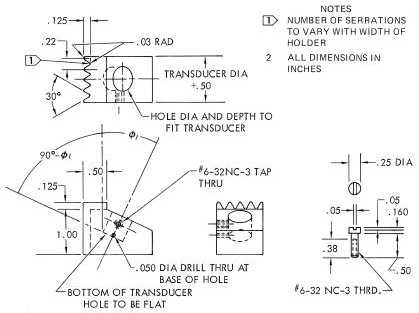T.O. 33B-1-1
5-33
5.2.2.9.2
Guidelines for Use of Curved Wedges and Shoes.
a. Required for all convex surfaces with a radius of curvature of 1.5 inches or less. Recommended for all
convex surfaces with a radius of curvature between 1.5 and 4.0 inches.
b. Required for all concave surfaces with a radius of curvature of less than 4 inches.
5.2.2.10
Design And Fabrication Of Wedges And Shoes.
CAUTION
Excessive heat generated during fabrication (machining or sanding) of acrylic
plastic wedges and delay elements can significantly increase the attenuation of
ultrasound in this material.
a. Plastic wedges and shoes can be fabricated from polystyrene, Lucite or other acrylic plastic (Item A,
Type 1, Grade C plastic of Federal Specification L-P-391). Before using a plastic, a sample shall be
checked to insure that sound can be transmitted through the material. Some plastics will scatter
ultrasonic energy. The sample shall be at least as thick as the wedge or shoe to be fabricated. Check
the sample using straight beam inspection and note the back reflection signal. If a strong back
reflection (at least 100% of saturation) cannot be obtained, new material must be procured. The sample
shall be checked using the highest frequency that will be used with the completed wedge or shoe.
b. Angle beam wedges may be fabricated according to Figure 5-36 or Figure 5-38. The wedge in Figure 5-
36 has provisions built in for mounting the straight-beam search unit, while the wedge in Figure 5-38
requires a coupling fixture (Figure 5-37) for mounting the straight-beam search unit. Similar fixtures
may be procured or locally manufactured. The incident angle, f1, for each wedge shall be determined
from Snell’s law using the respective velocities of the wedge and the test material and the refracted
angle, f2, required by the inspection procedure. Table 5-3 contains values for f1 calculated for listed
refracted angles in six materials.
Figure 5-36. Angle Beam Wedge with Hole for Mounting Search Unit.

